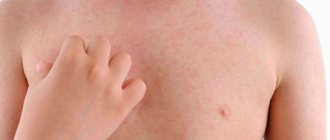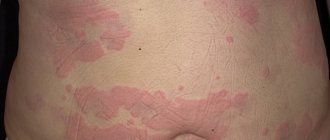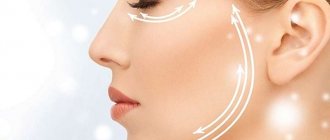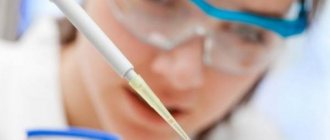Types of urticaria
Urticaria can be acute or chronic. The first is more common in preschool and teenage children. Lasts up to one and a half months. Skin rashes can be in the form of spots or blisters (their diameter often exceeds 1 cm).
Chronic urticaria lasts more than one and a half months. It is usually diagnosed in people aged 20-40 years. Periods of remission are periodically replaced by exacerbations, which affects the size and number of spots on the body.
Depending on the cause of the disease, urticaria is classified into:
- Contact/allergic.
- Urticarial vasculitis (the walls of small vessels and skin capillaries become inflamed).
- Medicinal.
- Physical: - cholinergic; - dermographic; - cold; - caused by physical activity; — slowed down by pressure; - solar; - aquagenic (skin reaction to contact with liquids (pure water does not cause a reaction); - vibration.
- Idiopathic (the cause of the problem remains unclear).
Causes of urticaria
Blisters on the skin and mucous membranes with urticaria are formed due to the release of histamine into the blood. Under the influence of allergic components, the capillary walls become more permeable, so fluid from the vessels freely enters the dermis, and blisters form.
Hives can be caused by:
- Medicines (NSAIDs, antibiotics).
- Food products (considered allergenic: seafood, eggs, nuts, fish, milk, citrus fruits, cocoa, etc.).
- Contact with latex, household chemicals.
- Fungal skin diseases.
- Tonsillitis, pharyngitis, sinusitis.
- Serum sickness.
- Hypo- and hyperthyroidism and other thyroid diseases.
- Streptococcus, Yersinia, Staphylococcus.
- Insect bites (hornets, wasps, bees, less commonly mosquitoes).
- Parasites.
- Stress.
The risk of developing hives increases significantly if:
- In addition to a tendency to allergic reactions, the patient has bronchial asthma and rhinitis.
- The patient has an upper or lower respiratory tract infection.
- There are gastrointestinal diseases and tumors.
- Climatic conditions have changed (when changing place of residence).
- The patient spent a long time in the cold, in direct sunlight.
Causes
Allergic urticaria can occur in both adults and children. However, it is believed that children are most susceptible to developing rashes on the surface of the skin under the influence of various irritants. The reasons for the formation of a rash can be different.
The main factor in the occurrence of urticaria is contact with an allergen. They release substances that most often negatively affect the body of adults and children. The list includes:
- medications (antibacterial agents, vitamins, oral contraceptives);
- aeroallergens (plant pollen, animal hair, household dust);
- food (fish, nuts, seafood, eggs, honey, chocolate, berries and fruits);
- additives used in food preparation (flavors, dyes, emulsifiers);
- viruses (hepatitis B, Epstein-Barr).
The causes of allergic urticaria lie in the influence of physical factors. Among them are:
- water;
- Sun;
- warm;
- cold;
- vibration.
When determining the cause of the formation of a skin rash, one should not exclude the negative consequences of various chronic diseases. In adults and children, allergic urticaria may appear in the presence of:
- toxicosis;
- dysfunction of the gastrointestinal tract;
- respiratory and urogenital lesions by fungi and viruses;
- autoimmune and systemic diseases;
- pathologies of the liver and kidneys;
- endocrine disorders (diabetes mellitus, hypothyroidism);
- tumors of various types.
If you find signs of urticaria, which can be seen in the photo, you must consult a doctor to find out the cause of the allergic disease.
Symptoms of urticaria
Among the main symptoms of urticaria:
- skin redness;
- the appearance of red spots on any part of the body (as if from contact with nettles);
- formation of blisters (they can be seen by looking at a photo of hives);
- itching, burning of the skin;
- disappearance of rashes within one day.
If we talk in more detail about the unique signs of different types of urticaria, then:
- With the dermographic form, blisters form as the scratching progresses.
- In the nervous form, the rash occupies large areas of the body and goes away within half an hour. Fainting, dizziness, and increased sweating may occur.
- With cold urticaria, blisters occur precisely during exposure to the cold. After warming up, they very quickly disappear without a trace. There is a risk of developing Quincke's edema.
- With the sun form, the skin becomes covered with spots in the first minutes of exposure to direct sunlight. Possible fainting, obstructive pulmonary disease, hypotension.
- With the contact form, blisters appear only in those areas that came into contact with the allergen.
Dangerous symptoms of urticaria
Anaphylactic shock is the most dangerous symptom of urticaria and can be fatal. You can suspect its development based on the following signs:
- swelling of the neck, tongue;
- a sharp decrease in blood pressure;
- severe abdominal pain;
- fainting;
- feeling of lack of air, hoarseness of voice.
If you experience similar symptoms, consult your doctor
. It is easier to prevent a disease than to deal with the consequences.
Allergic urticaria in children
Children are very susceptible to skin rashes, and this is the most common reaction in the case of allergies. Children under 3 years of age most often suffer from manifestations of nettle fever. But older children can also experience trouble in the form of itchy rashes.
The location of blisters is similar to adults - on the extremities (most often in folds and places of close contact with clothing), around the mouth or eyes.
The mechanism of manifestation of the rash is the formation of a large amount of histamine due to the penetration of an allergen substance into the body. The surface of the skin becomes swollen and blisters form. The skin lesion disappears quite quickly and without a trace if the child does not scratch the sore spot. But then it can appear again, in another part of the body.
The doctor can quickly diagnose the cause that provoked the hives if the parents determine the time and place of the first appearance of the spots. Accurate diagnosis involves taking the following samples: skin scraping and blood test.
Diagnosis of urticaria
The doctor can make a preliminary diagnosis immediately after examining the patient’s skin. The spots that appear on the body due to urticaria are difficult to confuse with another skin pathology. But in order to eliminate error, establish the cause of the disease and prescribe the most effective treatment, the patient is additionally prescribed tests:
- General blood analysis. This is done in order to understand whether there is anemia, whether the erythrocyte sedimentation rate (ESR) is increased and, thus, exclude/confirm the presence of immune or inflammatory processes.
- Stool analysis. Indicated for the detection of parasites as a cause of allergic urticaria.
- Functional liver tests. They determine the functioning of the organ and exclude its diseases.
Also during diagnosis, a study of thyroid function is usually carried out to find out whether the disease is caused by hyper- or hypothyroidism.
To identify the allergen that is responsible for hives, the patient is recommended to do skin allergy tests or donate blood from a vein.
3. Diagnosis of rashes
Idiopathic urticaria can only be diagnosed by an allergist.
.
To do this, he prescribes a series of examinations, the purpose of which is to identify the connection of skin manifestations with specific factors and causes, the elimination of which could prevent the development or exacerbation of urticaria. The patient undergoes the following tests:
- general clinical blood test;
- biochemistry;
- HIV testing;
- blood for the Wasserman reaction;
- general urine analysis;
- blood and feces to identify parasites and helminths.
An important diagnostic step is a conversation with the patient
, during which the possible dependence of skin rashes on food, chemicals, stress, heredity, and medications taken is clarified.
Sometimes it is recommended to keep a symptomatic diary
, where each exacerbation of urticaria is recorded. In this case, the patient should try to remember any previous factors that could affect the state of the body, and also write them down. Sometimes only such records allow us to trace a certain pattern.
If a significant period of careful observation does not give a clear picture, there are no chronic diseases and exacerbations are unsystematic, then a diagnosis of “idiopathic allergy” is made.
About our clinic Chistye Prudy metro station Medintercom page!
Treatment of urticaria
Urticaria is not considered a dangerous disease unless it is associated with angioedema and suffocation. Experts recommend immediately contacting an allergist.
seek qualified medical help if:
- the patient begins to choke;
- he has swelling of his tongue/pharynx;
- hives cannot be treated at home.
In order for the treatment of urticaria to be as effective as possible, it is necessary to stop the negative impact of the allergen on the body. It all depends on the cause of the disease. So, if we are talking about the solar form, you need to get out of the scorching sun, if you are talking about the cold form, you need to get out of the cold air into a warm room. If the rash is caused by a drug, you need to stop taking it and drink some enterosorbent. It is also important to take an antihistamine right away. It could be:
- "Zodak", Zyrtek";
- "Loratadine";
- "Allergozan", "Suprastin";
- "Parlazin";
- "Ebastine" and others.
If antihistamines do not provide improvement in the patient’s condition within 24 hours, you should take hormonal tablets - Prednisolone or Dexamethasone.
Locally, urticaria can be treated with ointments:
- Non-hormonal (Soventol, Fenistil gel, Psilo-balm).
- Hormonal (Sinaflan, Flucinar, Laticort, Hydrocortisone, Fluorocort, Advantan, Afloderm, Cloveit, Lokoid, Dermovate).
Immunosuppressants (for example, Cyclosporine) are indicated for patients with severe forms of autoimmune urticaria and when antihistamines are ineffective. You should first consult an allergist-immunologist.
.
Traditional treatment for urticaria
The following decoctions help eliminate the symptoms of acute urticaria:
- Pour 50 g of nettle leaves into 2 cups of boiling water. Leave for 1 hour. Strain. Soak the cloth in the broth and apply to the inflamed skin.
- Pour 50 g of raspberry roots with 2 glasses of water. Boil for 15 minutes. Leave for 1 hour. Take the decoction orally, 100 ml 5-6 times a day.
For chronic urticaria, the following recipe helps:
- Mix celandine, string, sage, chamomile, and valerian in equal proportions. 5 tbsp. collection, pour a liter of boiling water and keep on low heat for 5 minutes. Add the resulting broth to the bath. The duration of the water procedure is 15 minutes. You need to repeat it every day for a week.
For allergic urticaria, you should grind the roots of the marsh calamus and take 1/2 tsp. once a day with water. St. John's wort oil also helps. They are recommended to wipe the inflamed areas of the skin.
You can fight nervous urticaria with a mixture of valerian and hawthorn. Add 30 drops of these compositions to water and drink before bed. Mint infusion is also effective. It can be prepared until acute symptoms are eliminated instead of regular black tea.
If urticaria often recurs, you can resort to the help of hop cones, valerian roots and lemon balm. To do this you need to mix 1 tbsp. each of the named types of plant materials, pour a glass of boiling water over the mixture and leave. After an hour, strain. Take half a glass three times a day.
Chronic urticaria (CU) is hives that occur every day for more than 6 weeks. Chronic idiopathic urticaria, which has no obvious external cause, comprises the majority of cases of CU. It is believed that in more than half of all cases of chronic idiopathic urticaria, an autoimmune mechanism occurs due to antibodies to the high-affinity receptors (FcεRI) of immunoglobulin E. CU is believed to arise from the tendency of the patient's immune system to develop reactions against its own body. A strong association supporting this hypothesis has been found between CU and autoimmune diseases such as thyroid disease (autoimmune thyropathies), rheumatoid arthritis (RA), systemic lupus erythematosus (SLE), Sjögren's syndrome, celiac disease, and type 1 diabetes. Based on this, we consider the relationship between CU, autoimmune thyropathies and other autoimmune disorders, as well as implications from this statement that may have implications for therapeutic intervention in CU.
Introduction.
It is estimated that 25% of the population will develop urticaria during their lifetime. HC is urticaria that occurs daily for more than 6 weeks. CU usually lasts 1–5 years, but can last more than 5 years in approximately 14% of patients. \Individuals with chronic chronic disease report emotional distress, a feeling of isolation and fatigue from this disease, similar findings are observed in patients with coronary heart disease. This highlights the importance of treating CU while minimizing both the physical and mental impact of the disease. CU may arise from drugs, physical stimuli, be part of inflammatory or congenital diseases, or may be idiopathic in nature. Acetylsalicylic acid (ASA) or nonsteroidal anti-inflammatory drugs (NSAIDs) exacerbate CU, presumably by inhibiting the cyclooxygenase pathway by increasing leukotriene production. Physical urticaria (classically divided into heat, cold, solar, vibration, delayed pressure response, dermatographic, aquagenic, and cholinergic) occurs in response to external stimuli. Urticarial vasculitis is the appearance of urticarial rashes lasting more than 24 hours with histopathological changes in the vessels. Congenital CU syndromes include a spectrum of cryopyrinopathies such as familial cold autoinflammatory syndrome, Muckle-Wales syndrome, and neonatal multisystem inflammatory disease/chronic infantile neurological cutaneous-articular syndrome (NOMID/CINCA). Hives can be a symptom of many inflammatory diseases, such as Schnitzler's syndrome, Still's disease and Gleich's syndrome. Chronic idiopathic urticaria, unlike physical urticaria and intolerance to ASA or NSAIDs, has no obvious external cause. Chronic idiopathic urticaria is the most common type of urticaria, comprising up to 90% of all cases of urticaria. Chronic idiopathic urticaria is thought to affect 0.6 to 5% of the population. It is believed that more than half of cases of chronic idiopathic urticaria have an autoimmune mechanism. This is supported by the observation that 60% of patients with chronic idiopathic urticaria experience a wheal or flare reaction when autologous serum is administered intradermally when skin testing with autologous serum is performed. About 50% of patients with chronic idiopathic urticaria have specific IgG for the high-affinity IgE receptor (FcεRI). These autoantibodies activate skin mast cells, circulating basophils, and the complement system. Additional immunologic abnormalities that play a causative role in CC have been described and include IgG directed against IgE and low-affinity IgE receptors (FcεRII), antiendothelial antibodies, and C8 alpha-gamma deficiency in the complement system. Approximately 35% of patients with chronic idiopathic urticaria experience episodes of angioedema, and 25% have positive dermatographism. Like many autoimmune diseases, chronic idiopathic urticaria is more common among women than men, with a gender incidence of 2:1 to 4:1 reported by the authors. The variety of autoimmune conditions associated with chronic idiopathic urticaria include autoimmune thyropathies, celiac disease, and RA. The purpose of this review is to discuss the relationship of CU with autoimmune thyropathy and other autoimmune diseases, as well as the implications of this situation, which may be important for therapeutic intervention in CU.
Autoimmune thyropathy and CC.
Autoimmune thyropathy is the most commonly reported autoimmune condition in patients with CU. In the literature, the frequency of autoimmune lesions of the thyroid gland in patients with CU varies from 6.5% to 57%. Patients with coexisting autoimmune pathology and urticaria have a longer duration of urticaria, in contrast to those who do not have it. Patients with both CC and autoimmune pathology have an increased risk of developing angioedema. Leznoff and Sussmann reported that the triad of autoimmune thyropathy, CU, and angioedema occurs in 15% of those with CU. The risk of developing angioedema in patients with autoimmune thyropathy and CU is estimated to be 16.2 times higher than in patients with CU without thyropathy. In a recent large study of 12,778 patients with CU, Cofino-Cohen et al. it was found that 9.8% of patients had hypothyroidism, compared with 0.6% in the control group. Hypothyroidism was the most frequently identified autoimmune thyroidopathy in patients with CU. Women were more likely to have a combination of hypothyroidism and chronic hyperthyroidism than men. Patients with hyperthyroidism and CU comprised 2.7% of the study population, compared with 0.09% in the control group. In most patients, autoimmune thyropathy was identified in the next 10 years after the diagnosis of CU. This means that autoimmune thyropathy developed after the first manifestation of CU. In the same study, antithyroid antibodies were a significantly more common finding in patients with CU compared with controls. Among patients with CU who clinically had no signs of damage to the thyroid gland, antibodies to thyroid peroxidase were detected on average in 2.7%, antibodies to thyroglobulin - in 0.6%. Aamir et al. also noted a connection between antithyroid antibodies and CC, because The level of antibodies to thyroglobulin and microsomes was significantly increased among patients with CU and hypothyroidism. The development of autoimmune thyropathy is often considered a marker of autoimmunity. Autoimmune thyropathy is associated with a variety of autoimmune diseases, including in addition to CU, pernicious anemia, celiac disease, type 1 diabetes and SLE. Although the specific mechanism between the development of autoimmune thyropathy and CU has not yet been clearly established, it is widely believed that both diseases occur due to the tendency patient to the development of autoimmune reactions. It has been hypothesized that autoimmune thyropathy may worsen urticaria and angioedema by activating the complement system. Blanchin et al. demonstrated that thyroid peroxidase contains a domain that binds complement protein C4, activates it to C4a, and activates complement via the classical pathway. Kirpatrick noted that C4a levels are reduced in treated autoimmune thyropathy, leading to remission of CU. Based on this, a theory has been put forward that autoimmune thyropathy and CU can coexist due to the patient’s tendency to autoimmune reactions, and that autoimmune thyropathy can further aggravate the course of urticaria and angioedema through direct mechanisms of complement activation.
Other autoimmune diseases and chronic urticaria.
In addition to autoimmune thyropathy, many autoimmune diseases have been studied for association with CU. Confino-Cohen et al. showed that 12.5% of patients have another autoimmune disease, 2.1% have 2 diseases, 0.1% have 3 diseases, and a few patients have 4 or 5 diseases. Among patients with chronic hyperthyroidism and hypothyroidism, RA was the most common. The incidence of RA was 13.25 times higher among patients with CU than in the control group. Ryhal et al. showed that the main laboratory marker of RA, rheumatoid factor, was significantly elevated in patients with CU. Patients with CU of both sexes have an increased risk of developing type 1 diabetes. Among women with CU, the incidence of Sjögren's syndrome, celiac disease, or SLE was significantly higher than in controls. Most patients were diagnosed with an additional autoimmune disease within 10 years of CU diagnosis, highlighting that the diseases developed sequentially and were not incidentally discovered at the time of CU diagnosis. The association between celiac disease and CU has been previously discussed in the pediatric population. Asero et al. CC and Raynaud's phenomenon with positive anticentromere antibodies have been described. Other autoimmune diseases such as vitiligo and pernicious anemia have also been associated with CU. CU has been shown to have a genetic link to the human leukocyte antigen alleles HLA-DR4 and HLA-DQ8. HLA-DR4 is significantly associated with RA, HLA-DQ8 – with celiac disease and type 1 diabetes. Complement deficiency is associated with autoimmune diseases such as Sjögren's syndrome, RA, and SLE, as evidenced by the report of Park et al. about the development of CC, spondyloarthropathy and the presence of antinuclear antibodies in a 9-year-old boy with C8α-γ deficiency. CU was described in a 10-year-old boy with a strong autoimmune phenotype. The full list of diseases included total alopecia, vitiligo, psoriasis, Graves' disease, chronic hyperplasia, the autoimmune form of Lambert-Eaton myasthenic syndrome, and IgA deficiency. This patient had HLA genes that were found in the expanded haplotype 8.1 (ancestral haplotype), which is associated with the development of many autoimmune conditions. These cases clearly show that CU can occur as a manifestation of a combination of autoimmune diseases.
Treatment.
Treatment guidelines for CU were based on the GRADE approach. The second generation of non-sedating histamine type 1 receptor blockers is the 1st line of treatment for patients with CU. If the effect is not achieved within 2 weeks, a 2nd line of therapy is used, which consists of a 4-fold increase in the dose of antihistamines from the standard dose. Patients should be informed that symptoms of sedation and drug interactions may occur with increasing dosage. Cetirizine, desloratodine, fexofenadine and bilastine have been identified as the safest antihistamines when the dosage is increased. In 50% of observed patients, symptoms persist when using monotherapy with antihistamines. The 3rd line of therapy includes replacing antihistamines or combining them with leukotriene receptor antagonists. Leukotriene receptor antagonists are indicated for the improvement of patients with intolerance to ASA or NSAIDs in urticaria, with a positive skin test with autologous serum, or in urticaria with food hypersensitivity, but not in chronic idiopathic urticaria. A short 3-7 day course of systemic steroids can be used in conjunction with 3rd line therapy. If the 3rd line of therapy is unsuccessful, proceed to the 4th line of therapy, including the use of cyclosporine A, type 2 histamine receptor blockers, dapsone or omalizumab. The most effective in the 4th line of therapy for CC is omalizumab, monoclonal antibodies against IgE, used for treatment of severe forms of asthma. Mauer et al. published a randomized, double-blind study evaluating the effectiveness of omalizumab among patients with CU who had failed first-line therapy and showed a significant reduction in CU symptoms. Omalizumab reduced free IgE and levels of high-affinity IgE receptors on mast cells and basophils (cells thought to be responsible for the development of blisters in CU). The literature reports additional treatment for patients who fail 4th line therapy, which includes mycophenolate mofetil, methotrexate, tacrolimus, sulfasalazine and intravenous immunoglobulin. Treatment of concomitant autoimmune thyropathy has been reported to induce remission of CU. Kirkpatrick conducted a study in CU patients with apparent clinical or serological autoimmune thyropathy. In addition, first-line therapy with antihistamines was ineffective among these patients. It was demonstrated that levothyroxine induced remission of angioedema and urticaria in all 6 patients with autoimmune thyropathy and CU. Rumbryt reported obtaining clinical remission of CU in 7 out of 10 euthyroid patients with antithyroid antibodies by administering thyroxine, but when CU relapsed, therapy was discontinued. These studies suggest that treatment with levothyroxine may play a role in remission of CU in patients with CU and clinically diagnosed autoimmune thyropathy. However, Magen et al. recently compared patients with CU and autoimmune thyropathy treated with levothyroxine with patients with CU and euthyroid status (control). Patients treated with levothyroxine showed clinical improvement in urticaria, but no similar improvement was observed in the control group. This led to the conclusion that improvement in clinical symptoms in CU occurred spontaneously, regardless of treatment. Controversial data in the literature regarding the importance of treating autoimmune thyropathy in CU indicates the need for additional extensive research to establish the role of levothyroxine in patients with CU. The use of NSAIDs demonstrated a worsening of CU in an average of 20% of patients with a primary diagnosis of CU. NSAIDs are widely used to treat pain and inflammation associated with RA, inflammatory spondylopathies, and lupus arthritis. Autoimmune inflammatory arthropathies, especially RA, have been shown to be more common in patients with CU than in the general population. Therefore, exacerbation of CU symptoms due to NSAID use should be closely monitored in patients with CU and autoimmune arthropathies. Zembowitcz et al. demonstrated that selective COX-2 inhibitors do not cause urticaria in patients with CU, as is the case with NSAIDs. According to this, it is assumed that selective COX-2 inhibitors are preferable to NSAIDs in terms of preventing exacerbation of CC. It was previously assumed that Helicobacter pylori (H. pylori) may be an etiological factor in CU. This was supported by reports demonstrating a high incidence of H. pylori among patients with CU and improvement in clinical symptoms following eradication. But this assumption was questionable, since a number of authors did not find differences in the production of antibodies in patients with H. pylori and CC and the control group. Additional evidence was also demonstrated that eradication did not affect clinical recovery in CU. This discrepancy in the literature occurs due to differences in detection methods, resistance to therapy, and the possible return of H. pylori soon after treatment. Adding further confusion is recent evidence suggesting that eradication may be a trigger for CC. Shakouri et al. performed a review of the literature regarding H. pylori eradication and CU using the GRADE system, and concluded that the evidence for treatment was weak and more studies are needed to establish whether H. pylori eradication is beneficial for patients with CU.
Conclusion.
HC is urticaria with daily rash lasting more than 6 weeks. It is currently believed that up to 50% of cases of CU are caused by autoimmune mechanisms. The most commonly detected antibodies are those with high affinity for IgE receptors, which activate mast cells, basophils and the complement system, leading to blistering and worsening of the rash. It is assumed that CU occurs when the patient is predisposed to autoimmune diseases. Consistent with this hypothesis, other autoimmune diseases are also observed in patients with CU. Autoimmune thyroidopathy, hyperthyroidism in particular, is the most common concomitant autoimmune disease. Moreover, autoimmune thyropathy can directly aggravate the severity of CU by activating the complement system. Other autoimmune diseases that most often occur in patients with chronic urticaria are RA, SLE, vitiligo, pernicious anemia, celiac disease, and Sjögren's syndrome. In practice, CU may be part of a larger autoimmune phenotype. These connections are supported by the theory that patients who develop CU have an intrinsic predisposition to develop autoimmune reactions. According to the literature, treatment of autoimmune thyropathy has different effects on CU: induction of remission and no effect on the clinical course of CU. The treatment of autoimmune diseases, especially autoimmune thyropathy, in patients with CU is considered important, but further research is needed to justify this treatment in CU.
Diet for urticaria
During the treatment of urticaria caused by food intolerance, it is necessary to avoid eating foods that stimulate the release of histamine. These include:
- coffee, chocolate, honey;
- citrus fruits, nuts;
- products containing dyes, emulsifiers, preservatives;
- milk, chicken eggs;
- baking, mayonnaise, mushrooms, peas;
- chicken, spices, vinegar;
- soybeans, beans, pineapples and some others.
Strong tea, coffee and alcohol should also be avoided. Procedures such as freezing, cooking, and peeling help to slightly reduce the allergenicity of products.
The basis of the diet for allergic urticaria should be porridge cooked in water, vegetarian and cereal soups, baked apples, olive oil, compotes, kefir.
If the patient does not know what foods he has an allergic reaction to in the form of urticaria, he can act as follows:
- After eliminating the symptoms of the disease, do not eat anything for one day.
- From the second day, start eating one product at a time. At the same time, keep a food diary and monitor your condition.
When treating urticaria, it is important to drink a lot - at least two to three liters of water per day. This helps remove allergens from the body faster.
Acute urticaria
In this case, the symptoms of urticaria appear suddenly, it may be accompanied by general weakness, fever, and stomach upset. The rash in acute urticaria is localized on the torso, arms, legs, and buttocks. After some time, the rash may disappear and then appear again. This pattern can repeat itself over several days.
In most cases, the cause of acute urticaria is an allergy to a specific food or plant, as well as medications, shots and vaccines.
Why is urticaria dangerous?
Hives can lead to very severe allergic reactions - swelling of the tongue and throat, breathing problems and even anaphylactic shock. If these symptoms occur, it is important to immediately call an ambulance, otherwise the patient may suffocate.
In 1/3 of patients, urticaria becomes chronic, that is, even after treatment, from time to time it reminds itself of relapses. In 15% of patients it contributes to the development of depressive disorders.
It is important to know that urticaria can be a symptom of another, more serious disease - oncology.
Stages of urticaria
There are three main stages in the development of the disease:
| Immunological | It begins with human contact with an allergen. The body, as the irritant spreads, accumulates antibodies. |
| Pathochemical | At this stage, allergy mediators are formed during the body’s primary reaction. If this is a relapse of the disease, ready-made mediators are already in the body and are released. |
| Pathophysiological | The body responds to the stimulus. After an increase in the amount of mediators in the blood, the first symptoms of urticaria appear. |
Prevention of urticaria
There are no special measures to prevent hives from occurring. Help minimize the risk of developing the disease:
- Keeping a food diary (you need to write down everything that was eaten during the day and how you feel).
- Avoiding contact with potentially dangerous allergic compounds (foods, medications, low/high temperatures, etc.).
- Pre-purchase antihistamines for urticaria. Allergists recommend that all people who have at least once had an allergy keep tablets such as Suprastin, Zyrtek, Parlazin, etc. on hand. If you take them at the first symptoms of the pathology, you can avoid complications.
- Wearing loose-fitting clothing made from natural fabrics (provides high-quality air exchange and avoids additional irritation of the skin).
- Avoiding stressful situations.
- Elimination of allergenic foods from the diet.
- Competent and timely treatment of chronic diseases.
This article is posted for educational purposes only and does not constitute scientific material or professional medical advice.
Symptoms
There are characteristic signs that indicate nettle fever (see photo). Allergy symptoms of hives can vary in severity. These include:
- Swelling and redness of tissues;
- Temperature increase. Occurs if the rash occupies a large area;
- Joint pain;
- Convulsions, asphyxia, dizziness;
- Itching. Determines the severity of the disease. The most severe is painful itching, as a result of which insomnia and neurotic disorders develop;
- Rash. For different forms of the disease, the rash may differ. It can be small or large and consist of scarlet blisters with a bright red or white border, which is characteristic of acute urticaria. Sometimes they merge, forming large spots. With giant nettle fever, the blisters can reach enormous sizes, and with papular fever they can be supplemented with papules.
Consequences
The acute course of the disease can be complicated by a life-threatening condition – anaphylactic shock. Acute swelling of the larynx and the development of respiratory failure are also possible. Such conditions require emergency resuscitation. Therefore, at the first symptoms of urticaria, you should immediately consult a doctor for adequate treatment of this disease.
The chronic course of urticaria is often accompanied by a noticeable decrease in the quality of the patient and the occurrence of various psychoneurological disorders. They are associated mainly with the debilitating constant feeling of itching of the elements of urticaria on the body, as well as the aesthetic side of the problem.
Urticaria during pregnancy
During pregnancy, a woman’s body produces a large amount of female sex hormones (estrogens), which is essentially one of the risk factors for the development of urticaria. Characteristic features of urticaria in pregnant women are pronounced itching of the skin, scratching of the skin, insomnia, and irritability.
If a rash appears, it must be shown to a dermatologist, since in pregnant women, urticaria can be differentiated from dermatitis. I would like to note that in most cases of urticaria during pregnancy, the treatment is the same as the treatment for most adults.
How long does hives last?
The rash may disappear in one day, but this does not mean that the body has completely defeated the disease. The rash may reappear on other areas of the skin.
Sometimes urticaria can be accompanied by Quincke's edema, in which swelling of the skin and subcutaneous fat develops extremely quickly and sharply. Swelling of the larynx can lead to fatal events, and the appearance of hives on the eye can cause blurred vision. In such cases, you should not self-medicate; you should urgently contact a specialist who will tell you how to treat urticaria - an allergist.
Nutrition
The diet for this disease is not much different from the diet for other manifestations of allergies. It is imperative to exclude a product that provokes allergic reactions from the diet of an adult or child.
In addition, it is necessary to follow a hypoallergenic diet. Replace dairy products with fermented milk. Eliminate bright exotic fruits from your diet. You should not eat foods that you have not tried before. Very often, seafood causes allergies, so it is better to avoid them. You cannot eat nuts, raisins and prunes.
It is better to eat meat boiled or stewed. It shouldn't be too greasy. Vegetables are best consumed fresh or boiled. Fried foods should be avoided. Give preference to buckwheat and rice porridge, as well as boiled potatoes. Do not use hot spices or large amounts of salt when cooking.
How to treat hives?
Treatment of urticaria begins with identifying and eliminating those factors that provoked its development and subsequently cause exacerbations of the disease. The fight against this disease also involves taking measures aimed at reducing symptoms and strengthening the patient’s immunity.
For urticaria, the following treatment methods are relevant:
- taking pharmacological agents (injections, tablets);
- use of topical medications (ointments and creams);
- diet therapy;
- physiotherapeutic procedures.
For urticaria, a wide range of drugs are used, which are prescribed both in tablet form and in the form of injections. Tablets are usually used in the treatment of chronic forms of urticaria, as well as when the acute period has passed. Injections are most often prescribed during the provision of primary care and during the acute period of the disease.
Quincke's edema









